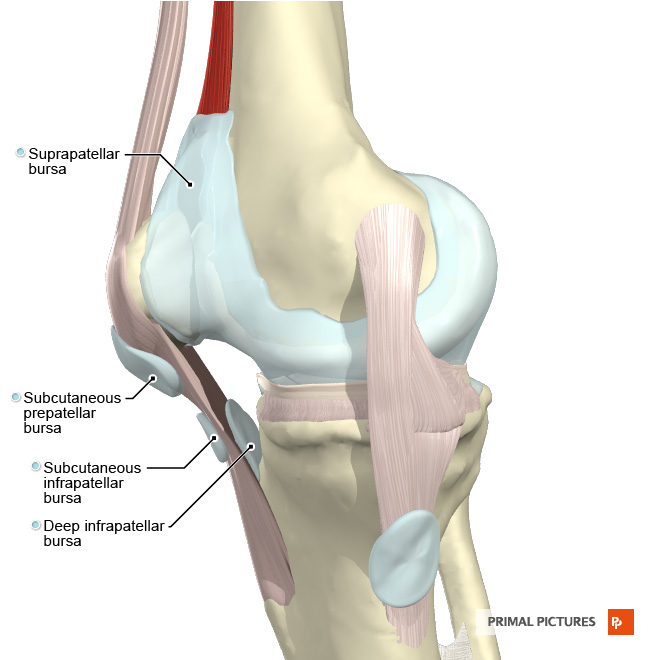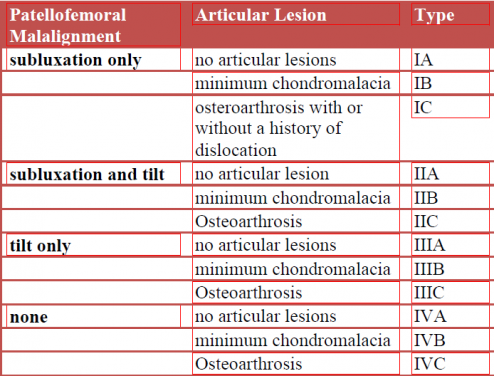Classification of Fulkerson and Shea for Malalignment in a Patient with Chronic Patellofemoral Pain: Difference between revisions
(added Sports Medicine category) |
Kim Jackson (talk | contribs) (Updated Primal Pictures image) |
||
| (4 intermediate revisions by the same user not shown) | |||
| Line 6: | Line 6: | ||
== Objective == | == Objective == | ||
Fulkerson and Shea reported a grading scheme for classifying patellofemoral malalignment in patients with chronic patellofemoral pain. <ref>Fulkerson JP, Shea KP. Disorders of Patellofemoral Alignment. J Bone Joint Surgery. 1990; 72-A: 1424-1429</ref> The authors are from the University of Connecticut. | [[Image:Patella_bursae_Primal.png|frame|right|300px]] Fulkerson and Shea reported a grading scheme for classifying patellofemoral malalignment in patients with chronic patellofemoral pain. <ref>Fulkerson JP, Shea KP. Disorders of Patellofemoral Alignment. J Bone Joint Surgery. 1990; 72-A: 1424-1429</ref> The authors are from the University of Connecticut. | ||
== Intended Population == | == Intended Population == | ||
| Line 31: | Line 22: | ||
• Minimum chrondromalacia corresponds to Grade 1 or 2 articular damage (see arthroscopic grading scheme for degeneration of articular cartilage). • Osteoarthrosis corresponds to Grade 3 or 4 (large areas of fibrillation or exposed bone. | • Minimum chrondromalacia corresponds to Grade 1 or 2 articular damage (see arthroscopic grading scheme for degeneration of articular cartilage). • Osteoarthrosis corresponds to Grade 3 or 4 (large areas of fibrillation or exposed bone. | ||
== References == | == References == | ||
| Line 44: | Line 29: | ||
[[Category:Pain]] | [[Category:Pain]] | ||
[[Category:Musculoskeletal/Orthopaedics|Orthopaedics]] | [[Category:Musculoskeletal/Orthopaedics|Orthopaedics]] | ||
[[Category: | [[Category:Assessment]] | ||
[[Category:Knee - Assessment and Examination]] | |||
[[Category:Sports Medicine]] | [[Category:Sports Medicine]] | ||
Latest revision as of 20:56, 20 December 2020
Original Editor - Ajay Upadhyay
Top Contributors - Laura Ritchie, Kim Jackson, Ajay Upadhyay, Daphne Jackson, Wanda van Niekerk, Admin and WikiSysop
Objective[edit | edit source]
Fulkerson and Shea reported a grading scheme for classifying patellofemoral malalignment in patients with chronic patellofemoral pain. [1] The authors are from the University of Connecticut.
Intended Population[edit | edit source]
Patients with chronic patellofemoral pain.
Method of Use[edit | edit source]
Parameters: (1) patellofemoral malalignment (2) articular lesion
where:
• Minimum chrondromalacia corresponds to Grade 1 or 2 articular damage (see arthroscopic grading scheme for degeneration of articular cartilage). • Osteoarthrosis corresponds to Grade 3 or 4 (large areas of fibrillation or exposed bone.
References[edit | edit source]
- ↑ Fulkerson JP, Shea KP. Disorders of Patellofemoral Alignment. J Bone Joint Surgery. 1990; 72-A: 1424-1429
.








